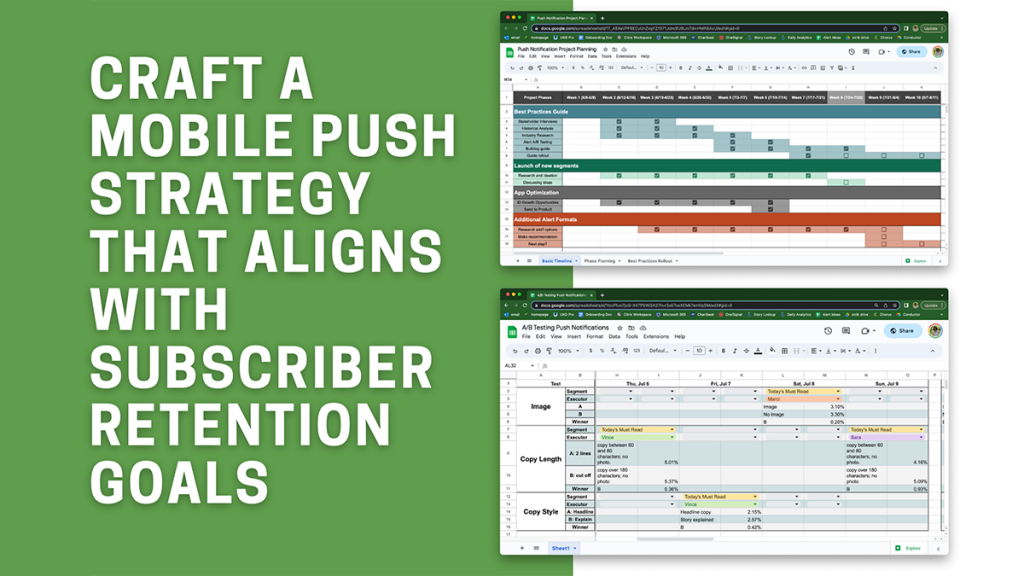
Build a push notification strategy that aligns with your subscriber retention goals
How the Star Tribune reimagined its push notification strategy from scratch
As a product and strategic initiative intern, my task was to “define a holistic approach to push notifications that maps to the Star Tribune’s ambitions around digital subscriptions and the Star Tribune being an indispensable news source for Minnesotans.”
Here’s how we did it:
1. Project planning
During onboarding, we had frequent conversations about where this project would lead, so we started with lots of ideas. To narrow the focus, we landed on four key projects:
- Build a best practices guide for the Star Tribune’s push notification strategy.
- Research and recommend new segment ideas to include in the app.
- Propose ways to optimize the app to improve the notification opt-in UX.
- Research additional ways to reach the audience via alerts like SMS, desktop notifications and Apple News.
Once we decided on those components, we laid out the week-by-week plan for the project.
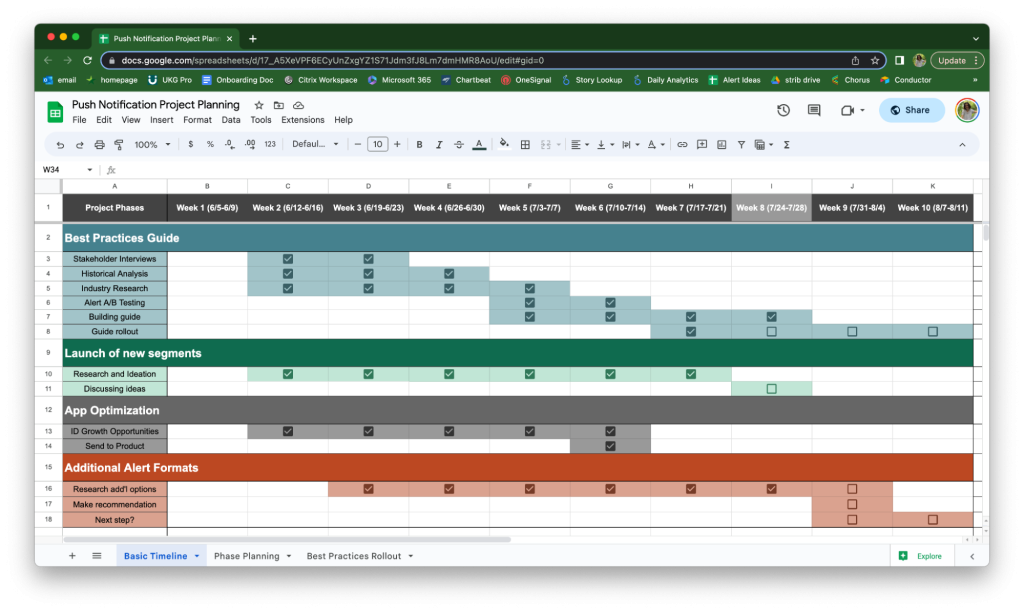
In addition to this timeline, we laid out my deliverables and objectives and key results (OKRs). This was really important to making sure I was on the same page with newsroom leaders about what was expected of the project by the final deliverable date.
Whenever we got to a place where we didn’t know what to do next, we were able to look back at these foundational documents to keep the project on track.
2. Collecting qualitative data
Internal interviews
To gather the institutional knowledge, we talked to every member of the audience team, such as the editors who send notifications every day, and the digital product team who are the product owners and data analysts.
This process was not only about learning their perspectives on the current strategy and workflow, it was also about getting buy-in on the new project from the start. We knew we would be making strategic decisions and it was important for those to be embraced by the team, especially for the sustainability of the strategy.
External interviews
The second part of qualitative data collection was talking to people working on alerts in other newsrooms. We put a call out in the News Product Alliance Slack and several people jumped to help.
We took a lot away from each exchange, the biggest revelation being the distinction between two types of notifications: breaking and engagement.
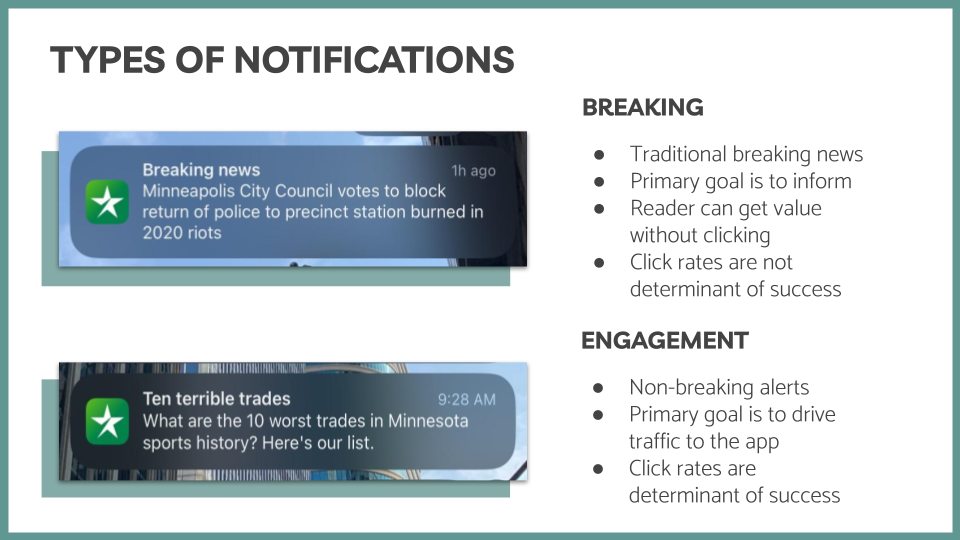
Differentiating between breaking and engagement alerts helps to craft a cohesive strategy
Here’s a couple key reads from our research:
- Why’d You Do That? How The Times Decides to Send News Alerts – New York Times
- Pushed Even Further: US Newsrooms View Mobile Alerts as a Standalone Platform – Columbia Journalism Review
- How The Dallas Morning News uses push notifications to grow audience – Better News
- Mobile App Push Notification Benchmarks for 2023 – Airship
3. Analyze historical and industry data
We used Python and Google Sheets to look at the last year and a half of the Star Tribune’s push notification data. Five questions from the stakeholder interviews helped us piece together:
- What is the best time to send push notifications?
- Is there a limit to how many we should be sending in a day?
- How long should our copy be?
- How much should we be pushing national vs. local stories?
- Should we be including images in our pushes?
Some of these questions got answered in the analysis and others got answered in the A/B testing.
In addition to this historical analysis, we tracked other publications’ notifications across a three-week period. In order to do this accurately (some human error may still occur), we downloaded more than 20 news apps and turned on every notification possible. We ended up tracking 13 local and two national organizations.
We tracked the times they sent notifications, how frequently they sent them, their naming conventions and use of photos or videos. We also collected the names of all their segments and any other lock screen features.
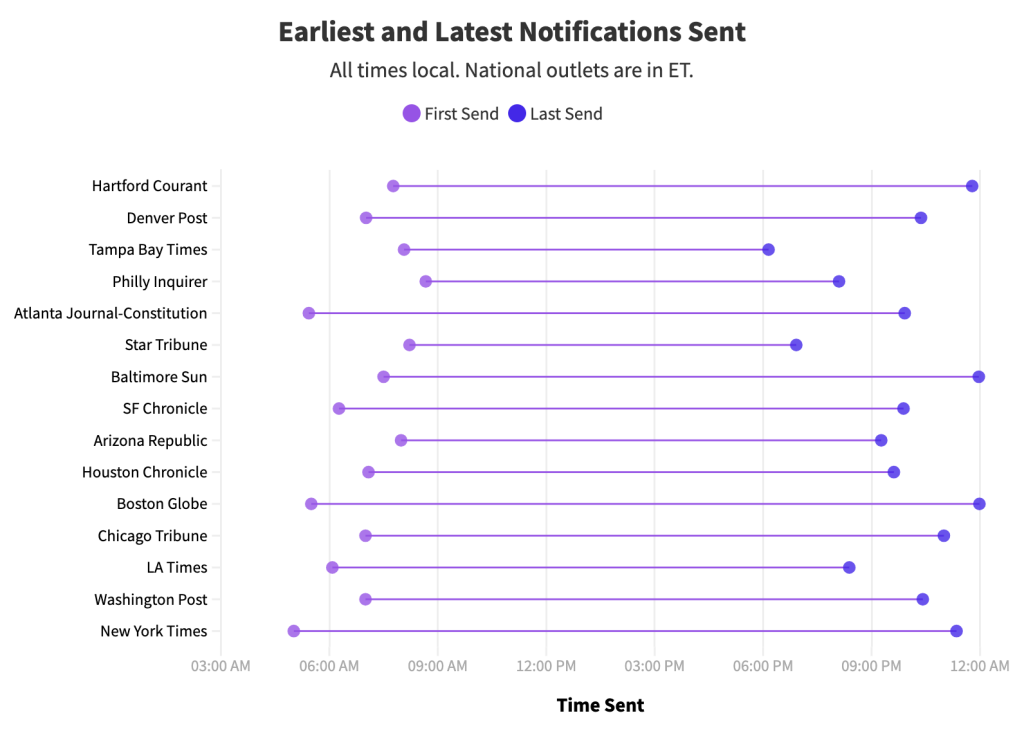
Graph showing the earliest and latest notifications sent by each outlet in the three-week tracking period.
In weeks six and seven, we presented this data to the audience, digital and product teams. Presenting this around the halfway point was just as much about giving the information as it was continuing to build buy-in. We wanted to keep people engaged in the project each week so they knew what was going on and how it would impact them.
4. Conduct A/B testing on notifications
With some questions answered and others still up in the air, we laid out a plan for A/B testing. We decided to test three things in our Today’s Must Read segment which gets sent once per day. I enlisted the help of three audience editors who are in charge of sending that notification each day.
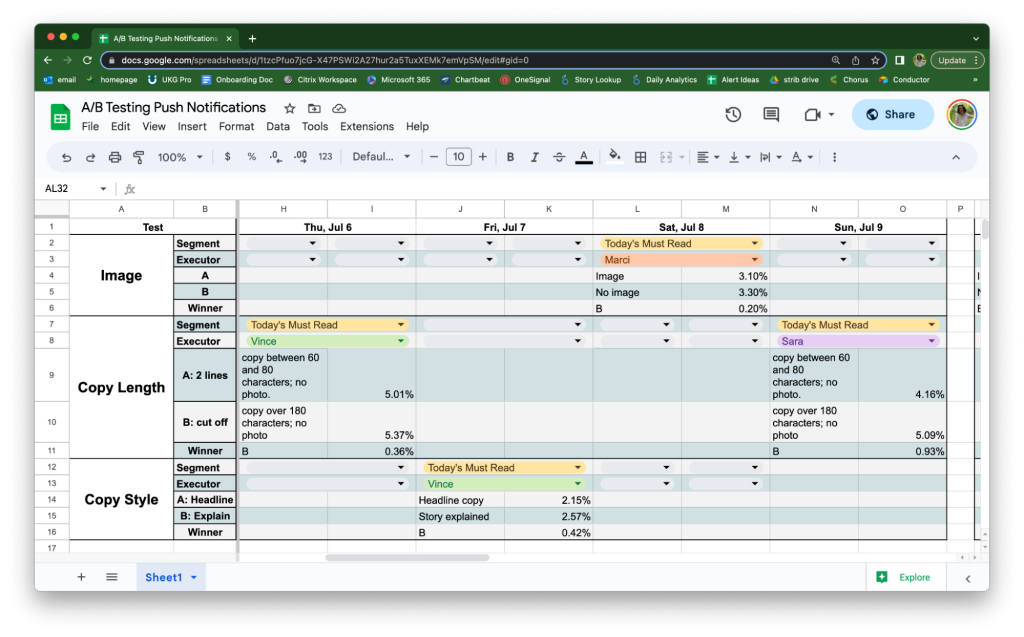
We didn’t have time to do as much A/B testing as we’d like, but the results gave us some insights into our audience’s tendencies. It’s important to note that we didn’t blindly follow this data, we used it as one piece of information to help set our strategy.
5. Build best practices guide
After all the research, analysis, interviews and testing, we started building the best practices guide, a two-page document that answered most of the original questions we laid out.
At its most basic level, this guide explained the Star Tribune’s philosophy around push notifications, which has four key parts:
- Push notifications are the most visible real estate available and link directly to a Star Tribune digital property, unlike any other platform.
- Push notifications are their own legitimate platform and should be strategized to the same degree you would for newsletters or the homepage.
- Push notifications are important to building habit and brand loyalty and retaining subscribers.
- Segmentation and personalization are the most efficient use of push notifications and result in higher click rates.
One of the most important takeaways in this guide is that some of our original questions couldn’t be answered due to a lack of conclusive data.
To continue progressing the strategy beyond my internship, we built a system to track analytics on a weekly basis outside of the notification tool. The plan is for this iterative structure to give the audience team consistent insights that allow them to improve the strategy each week.
6. Rollout guide
From the beginning, we planned for the guide rollout to begin in week eight, giving us three full weeks to train all the necessary people, get it implemented and still be around to address any challenges.
We presented the guide to the Audience and Product teams, along with other key groups in the newsroom like the multiplatform editors and members of the sports staff.
We also presented a version of my project in a session open to the whole newsroom. I explained the new push notification philosophy and how reporters and editors can contribute to the evolving strategy, making it a newsroom-wide initiative.
